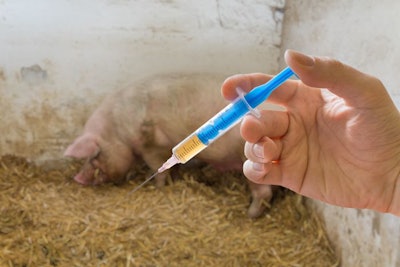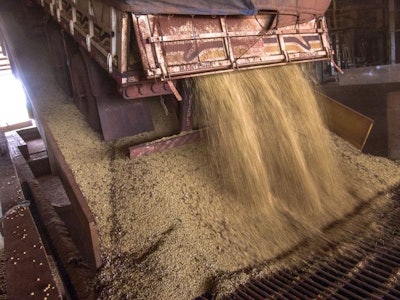
Learn what activities are happening in federal government, including at the Food and Drug Administration, Occupational Safety and Health Administration and US Department of Agriculture
With the new year comes a new Congress in the U.S. and a flurry of activity in Washington, including that related to several issues which affect the animal feed and grain industries.
The 118th United States Congress convenes on January 3 to begin work on new legislation. The American Feed Industry Association (AFIA) and the National Grain and Feed Association (NGFA) are keeping an eye on the farm bill, which expires in September. The farm bill affects all of agriculture, and NGFA said it will be working to support a strong safety net for agricultural producers, as well as emphasizing the importance of prioritizing policy that supports working lands conservation programs such as the Environmental Quality Incentives Program and the Conservation Stewardship Program instead of land-idling programs in the farm bill.
Leah Wilkinson, AFIA vice president of public policy and education, said AFIA will be watching how the climate is involved in discussions around the farm bill.
“The animal food industry, through basic animal nutrition and innovation, plays a role in our environment, and so we want to make sure that animal nutrition is recognized in any potential solutions or innovations that are offered via mechanisms in the farm bill,” Wilkinson said.
With the makeup of Congress split – Republicans control the House of Representatives while Democrats control the Senate – the farm bill will need to be bipartisan to clear the Senate, NGFA said.
“If Republicans control the House and aim to alter or reduce nutrition funding in the farm bill, the debate may extend the timeline for getting the bill passed,” NGFA staff said.
Food and Drug Administration regulations
There are several regulations that the U.S. Food and Drug Administration (FDA) is considering that affect the animal feed and agriculture industries.
FDA is reviewing the Center of Veterinary Medicine‘s (CVM) Policy and Procedures Manual (PPM) 1240.3605, Regulating Animal Foods with Drug Claims. These claims include environmental benefit or production claims and claims about the effects on the animal’s microbiome. FDA held a virtual public listening session on this in October and the public comment period ended in mid-November.
“We recognize some articles in animal diets with these types of claims are currently regulated as animal drugs,” Timothy Schell, director of FDA’s Office of Surveillance and Compliance, said in October. “Our evaluation of our current policy includes whether there could be changes to allow some articles currently regulated as animal drugs to be regulated like animal food. We’d like to underscore our goal of ensuring human and animal safety as well as consistency with current laws and regulations.”
Wilkinson said she hopes FDA will make a decision quickly “so that it can allow some of those products to flow into the regulatory pipeline for review and hopeful approval. … We can help provide some of those solutions, but we can’t do it if we can’t get approved products onto the market.”
NGFA said it is urging FDA to modernize its policy to allow animal feed ingredients to gain pre-market approval through normal feed ingredient approval pathways, which would allow products to come to market in a more efficient manner.
“By making the change, NGFA believes FDA would be furthering its commitment to the One Health Initiative, enabling innovative products to reach farmers and ranchers, allowing U.S. agriculture to compete in global markets, supporting the United States in achieving climate and food security goals, and advancing improvements in food safety,” NGFA staff said.
Somewhat related to this topic is government funding for the CVM for animal ingredient reviews.
“That’s important to the animal food industry because we have been seeking additional funds for FDA Center for Veterinary Medicine for our animal food ingredient reviews,” Wilkinson said.
In July 2022, the U.S. House of Representatives passed a “minibus” package of funding that included an amendment that dedicated US$8 million to CVM to expedite reviews for new feed ingredients by hiring additional staff and adding the necessary resources “to make sure that they are getting through the workload that’s there in a timely manner so that we can bring new products to the market and make sure they’re safe and approved for the animal food industry and pet food industry,” Wilkinson said.
According to AFIA, on average, studies have shown that it takes companies three to five years to get new ingredients through the FDA’s rigorous review process, which prevents innovation from making it to farmers and ranchers in a timely way.
- Controlling mycotoxin risks
The FDA is placing more emphasis on how facilities are controlling risks associated with mycotoxins, NGFA said.
“During recent animal food inspections, FDA’s enforcement actions indicate the agency generally expects some level of testing to be done to manage mycotoxin risk,” NGFA staff said. “The primary mycotoxins of interest to FDA are those for which regulatory guidance has been issued – aflatoxin, fumonisin and deoxynivalenol. Firms should consider how they are evaluating grains and grain byproducts that are susceptible to mycotoxins for safety and whether their practices are adequate. FDA also has indicated that it is interested in establishing new regulatory guidance for zearalenone and ochratoxin A.”
- Animal drug user feed program
The Animal Drug User Fee Act (ADUFA) – the user fee program for how animal drugs get approved – is up for reauthorization this year. It “amends the Federal Food, Drug, and Cosmetic Act and authorizes the FDA to collect fees for certain animal drug applications and supplements, products, establishments and sponsors of animal drug applications and/or investigational animal drug submissions. These resources support the FDA’s responsibilities to ensure that new animal drug products are safe and effective for animals, as well as ensuring the safety of food from treated animals,” according to FDA’s website.
 There are several regulations that the U.S. Food and Drug Administration (FDA) is considering that affect the animal feed and agriculture industries. (vchal | BigStock.com)
There are several regulations that the U.S. Food and Drug Administration (FDA) is considering that affect the animal feed and agriculture industries. (vchal | BigStock.com)“It’s different than what we have for feed ingredients, but it’s still that basic structure of making sure government works,” Wilkinson said. “It’ll be important for them to come to agreement, because these are important issues for all of agriculture.”
Occupational Safety and Health Administration standards
Like FDA, the Occupational Safety and Health Administration (OSHA) is considering several standards that may affect the feed and grain industries.
A proposed rule addressing a heat stress standard is expected to be published in early 2023.
“There is no set date for the next step in OSHA’s attempt to develop a heat stress standard, except to analyze comments in response to the agency’s advance notice of proposed rulemaking,” NGFA said.
NGFA submitted comments opposing the creation of a one-size-fits-all federal regulation to replace an existing program that OSHA can enforce through the General Duty Clause. In April 2022, OSHA issued its first-ever heat illness and injury National Emphasis Program (NEP), which is a temporary program that focuses OSHA’s resources on particular hazards and high-hazard industries. Grain-handling facilities fall under the scope of the NEP within high-risk industries.
Speaking on the Feed Strategy podcast in November 2022, Gary Huddleston, AFIA’s director of feed manufacturing and regulatory affairs, agreed with NGFA’s stance.
“If I had my way, I’d rather not even see a heat illness or injury standard. We don’t look for additional standards in our industry to comply with, but it does seem like the agency is headed in that direction,” he said. “If we do see a standard in this area on heat illness and injury, AFIA is going to watch it and we want to make sure that it doesn’t include any overly burdensome requirements for our manufacturers to deal with.”
However, he highly recommends that facilities have a written policy around heat illness and injury.
“That’s going to be one of the first requirements that we would see out of a standard is that you have a written policy, and a written programming around these types of injuries and illnesses. The basic elements of that program (are) going to be employee and supervisor training on recognizing the symptoms of heat illness, and then training your employees on how to protect themselves from heat injury and illness and climatization of new employees, especially if you hire employees in the hotter months,” he said. “With any safety-related programs, the purpose is to think through the hazards of the mitigation, think through those hazards and any kind of mitigation steps for those hazards, and then document effective policies and procedures to protect your employees.”
 The Occupational Safety and Health Administration (OSHA) is considering several standards that may affect the feed and grain industries. (howtogoto | BigStock.com)
The Occupational Safety and Health Administration (OSHA) is considering several standards that may affect the feed and grain industries. (howtogoto | BigStock.com)- Infectious disease standard
Additionally, NGFA said there is concern that, as a result of COVID-19, OSHA will change the scope of the infectious disease standard to apply to all workplaces in order to prepare for future pandemics. Huddleston said companies should also be prepared for this.
“I would encourage any employers to think through what they did in response to the COVID-19 pandemic,” Huddleston said. “If you don’t have a written program around infectious disease and preparedness, you should definitely do so. Whether we have a standard coming down the pike or not, it’s just a good business plan to have those things written out.”
Trade representatives
Elsewhere, Wilkinson said AFIA has been closely watching the nominations for the U.S. Trade Representative’s (USTR) chief agricultural negotiator and U.S. Department of Agriculture’s (USDA) undersecretary for trade and foreign agricultural affairs, both of which were recently confirmed by the Senate.
USTR staff work with the chief agricultural negotiator to remove trade barriers for U.S. agricultural exports and collaborate with colleagues across the U.S. government, particularly the USDA, to advance U.S. trade interests, according to the USTR’s website. USDA veteran Doug McKalip was confirmed by the Senate in late December to serve as the chief ag negotiator.
Alexis Taylor was also confirmed in December to serve as the USDA’s undersecretary for trade and foreign agricultural affairs, a position which helps provide U.S. farmers and ranchers with international trade opportunities. Taylor was previously director of the Oregon Department of Agriculture.
With these nominees confirmed, “finally (we’ll) have some time and attention focused on agriculture and trade, so it would be great for them to get in there so that they can start doing some work and get out promoting U.S. agriculture and helping us gain some of the progress we need on those market access issues that we haven’t been able to achieve these last two years,” Wilkinson said.
FGIS standards for soybeans
The Federal Grain Inspection Service (FGIS) announced in November 2022 that it will publish a proposed rule seeking public comment on changes to the U.S. Standards for Soybeans. NGFA and other stakeholders recommended that FGIS remove soybeans of other colors (SBOC) as a grade-determining factor for describing the quality of soybeans.
 NGFA and other stakeholders have recommended that FGIS remove soybeans of other colors (SBOC) as a grade-determining factor for describing the quality of soybeans. (Alfribeiro | BigStock.com)
NGFA and other stakeholders have recommended that FGIS remove soybeans of other colors (SBOC) as a grade-determining factor for describing the quality of soybeans. (Alfribeiro | BigStock.com)“The soybean industry has experienced an increased presence of SBOC over the past two years. According to FGIS, as the 2021 harvest was brought to market in 2022, the amount of SBOC increased nearly threefold compared to the previous year,” NGFA said.
USDA will implement notice and comment rulemaking on this topic, with a yet-to-be-determined date of publication. USDA said this process will take several months to complete, and it may conclude after the 2022-23 marketing year. NGFA said a recent study by FGIS, requested by the Grain Inspection Advisory Committee, found no significant differences in official protein or oil content in SBOC.
“Removal of SBOC as a grading factor will help promote the marketing of high-quality grain to both domestic and foreign buyers,” NGFA staff said.
Surface Transportation Board reauthorization, reforms
Efforts toward reauthorizing the Surface Transportation Board (STB) and making reforms to improve rail service made some progress in the previous Congress, and NGFA said the new split Congress will provide another opportunity to make reforms.
The STB is an independent federal agency that regulates and decides disputes involving railroad rates, railroad mergers or line sales, and certain other transportation matters.
“The Surface Transportation Board has a full docket, with consideration in progress for reciprocal switching, first-mile/last-mile rail service, rail rate review/arbitration, the Kansas City Southern Railway and Canadian Pacific Railway merger (scheduled for a decision in February), and rail service oversight,” NGFA said. “Each of these items is multi-year in nature and important to NGFA members.”
Cybersecurity guidance
In March 2022, Congress passed the Cyber Incident Reporting for Critical Infrastructure Act (CIRCIA), which directs the Cybersecurity and Infrastructure Security Agency (CISA) to develop regulations requiring covered entities to submit reports to CISA detailing cyber incidents and ransom payments within 24 hours for ransom payments and 72 hours for cyber incidents. CIRCIA requires CISA to publish a notice of proposed rulemaking by March 2024. NGFA submitted comments in November 2022 in response to the agency’s request for public feedback on details of future regulations.
“NGFA acknowledged the importance of cybersecurity and how the grain handling industry has been impacted. NGFA encouraged CISA to only allow significant incidents to be reported, keep the data confidential and exempt smaller businesses from the process,” NGFA said. “Further, NGFA requested that CISA make the reporting process simple, harmonize with other countries that require cyber reporting and provide resources to those who have been impacted.”
Emissions reporting
The Securities and Exchange Commission (SEC) proposed a rule in 2022 that would require SEC-registered companies to disclose greenhouse gas (GHG) emissions, including Scope 3 emissions – those related to downstream and upstream value chain participants.
“These proposals for GHG emissions disclosures would provide investors with decision-useful information to assess a registrant’s exposure to, and management of, climate-related risks and, in particular, transition risks,” SEC said on its website.
NGFA says these requirements would be burdensome.
“NGFA is concerned about the burdens this proposed reporting requirement would impose on the agricultural community and has urged SEC to not proceed with the requirement until it conducts broad stakeholder engagement and adequately addresses concerns,” it said.
NGFA staff contributions were submitted by Senior Vice President, Feed, David Fairfield; Chief Economist and Treasurer Max Fisher; Vice President, Safety and Regulatory Affairs, Jess McCluer; and Director of Communications and Digital Media Sarah Gonzalez.








